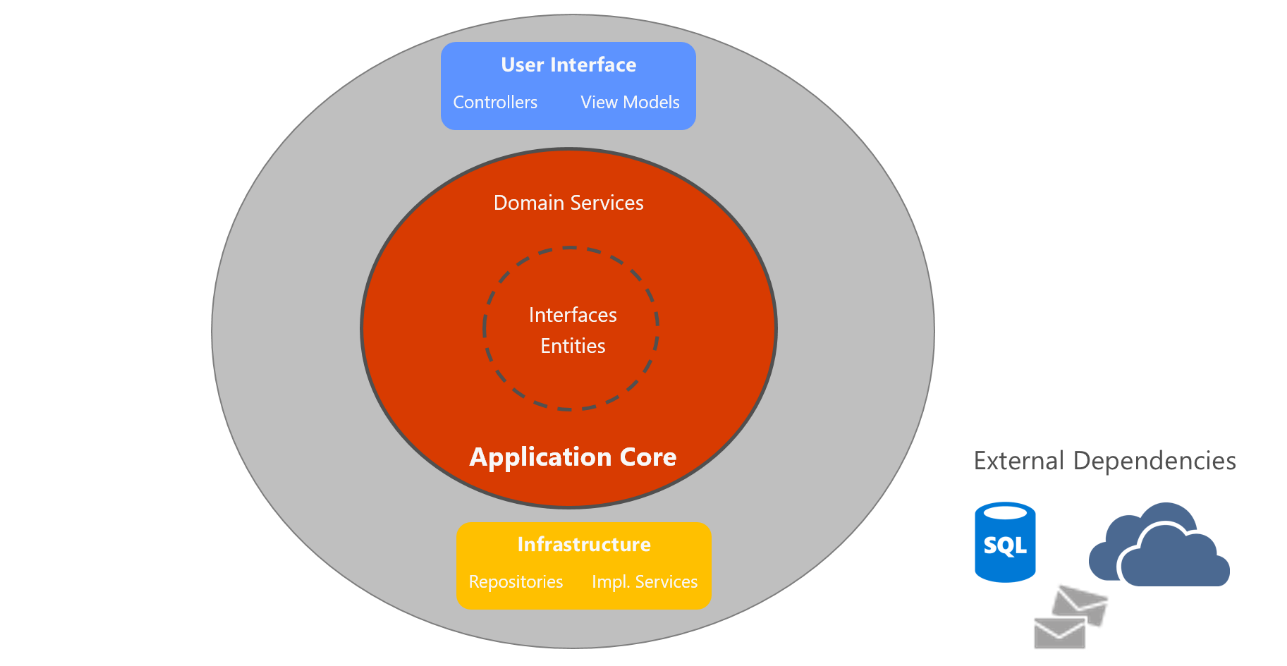Clean Architecture promotes software structure for
improved testability, maintainability, and
scalability. It separates concerns and supports a
flexible codebase to adapt to evolving requirements
and technologies.
Goals of Clean Architecture
Clean architecture aims to create software that is easy
to understand, maintain, and test. It emphasizes
separation of concerns and the creation of well-defined
boundaries between different parts of the application
parts. This separation allows for easier testing of
individual components.
Benefits of Clean Architecture
-
➤ Framework Independence: Can be used
with ASP.NET (Core), Java, Python, etc., without
relying on any specific software library or
proprietary codebase.
-
➤ Testability: Can be used with
ASP.NET (Core), Java, Python, etc., without relying on
any specific software library or proprietary codebase.
-
➤ UI Independence: Logic is kept out
of the UI, making it easy to switch technologies,
e.g., from Angular to React or Blazor.
-
➤ Database Independence: Cleanly
separates data-access concerns, facilitating changes
from SQL Server to CosmosDB.
-
➤ Independence from External Systems:
Core is completely isolated from the outside world,
ensuring longevity and ease of updates.
-
➤ Loose Coupling: Promotes loose
coupling between components and layers, enhancing
maintainability and scalability.
Clean Architecture: The Big Picture
-
1. Business Logic and Application Model at the
Center:
Ensures crucial aspects of the software are
independent and well-defined.
-
2. Inverted Dependency:
Business logic does not depend on data access or
infrastructure concerns; instead, infrastructure
depends on the Application Core.
-
3. Definite Abstractions in Application
Core:
Defines clear abstractions (interfaces) representing
essential contracts.
-
4. Implementation in the Infrastructure
Layer:
Concrete implementations are in the Infrastructure
layer, handling data access, external services, etc.
-
5. Inward Flow of Dependencies:
All dependencies flow inward towards the Application
Core, ensuring strict separation of concerns.
Layers in Clean Architecture
-
➤ Domain Layer:
Core of the architecture, implementing business logic
with no dependencies on other layers.
-
➤ Application Layer:
Middle layer, managing data between domain and
presentation/infrastructure layers.
-
➤ Infrastructure Layer:
Contains classes for accessing external resources like
file systems, web services, and databases.
-
➤ Presentation Layer:
UI code, using ASP.NET Core for building interfaces.
Domain Driven Design (DDD)
Domain-Driven Design (DDD) is a set of principles and
patterns for designing software that focuses on the core
domain and its logic. DDD emphasizes collaboration
between technical and domain experts to iteratively
refine a conceptual model that addresses complex
business requirements. The key concepts of DDD include:
| • Entities: |
Objects with a distinct identity that run through
different states in the system.
|
| • Value Objects: |
Immutable objects that represent a descriptive
aspect of the domain with no conceptual identity.
|
| • Aggregates: |
A cluster of domain objects that are treated as a
single unit for data changes.
|
| • Repositories: |
Mechanisms for encapsulating storage, retrieval, and
search behavior, imitating a collection of objects.
|
Testing in Clean Architecture
Testing in Clean Architecture involves testing each
layer independently to ensure that all components work
correctly and interact properly with one another. This
is a very crucial step and significantly reduces
complexity.
-
➤ Mocking: Creating objects that
simulate the behavior of real objects. In this case,
you can mock your database repositories without the
actual implementation.
-
➤ Dependency Injection: Passing
dependencies (such as repositories) into your use
cases or services to make them easier to perform unit
testing.
-
➤ Isolation: Ensuring that each test
is independent and does not rely on the state or data
of other tests.
Implementing Clean Architecture
-
1. Configuration of Domain Layer:
Define entities, enums, exceptions, interfaces, and
types.
-
2. Configuration of Application Layer:
Write business logic and service interfaces,
maintaining loose coupling.
-
3. Configuration of Infrastructure Layer:
Implement data access and external resource
interactions based on Core interfaces.
-
4. Configuration of Presentation Layer:
4. Configuration of Presentation Layer:
Principles to Follow
| 1. Separation of Concerns: |
Avoid mixing different code responsibilities in the
same method/class/project.
|
| 2. Single Responsibility: |
Each module/component should have only one reason to
change.
|
| 3. Don’t Repeat Yourself (DRY): |
Avoid duplicated code or logic. |
| 4. Inverted Dependencies: |
High-level policies should not depend on low-level
details; use dependency injection to promote loose
coupling.
|
Conclusion
Clean Architecture provides a robust foundation for
building microservices using .NET Core Web API. By
adhering to principles of separation of concerns and
dependency inversion, developers can create scalable,
maintainable, and testable applications. Embracing Clean
Architecture ensures a solid foundation for the
ever-changing demands of modern software development.
Learn more visit our GitHub




